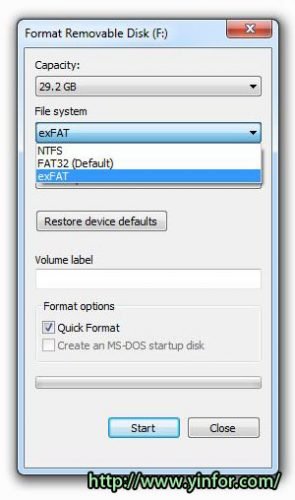Saw a new type of disk format, exFAT. I am only knowing FAT, FAT32, NTFS, and some others for Linux operation system.
Today, when I try to format a microSD card, it has a new option, exFAT.
What is exFAT?
File size limit is now 16 exabytes.
Format size limits and files per directory limits are practically eliminated.
Like HPFS, exFAT uses free space bitmaps to reduce fragmentation and free space allocation/detection issues.
Like HTFS, permission systems should be able to be attached through an access control list (ACL). It is unclear if or when Vista will include this feature, however.
Interestingly enough, exFAT is not used and was not designed for formatting hard drives. It is only recommended in flash memory storage and other external devices only. This is why it is currently not considered a huge competitor to NTFS on hard drives.
For me, I know that flash drive capacity is getting bigger and bigger. And also the file size, I mean the video file size is also getting bigger and bigger.
FAT32 has a limitation of 4GB file size limit.
NTFS and exFAt can store a single file with 5Gb or evern more.
NTFS vs exFAT (From Superusers)
From Wikipedia (my comments in bold):
- Scalability to large disk sizes: 64 ZiB theoretical max, 512 TiB recommended max, raised from the 16 TiB limit of FAT32 partitions. Note that the built-in Windows 2000/XP/Vista/7 can mount and support FAT32 volumes larger than 32 GB, but cannot create a FAT32 volume larger than 32 GB.
- Cluster size up to 32 MiB (allowing for larger partitions at the cost of more file slack)
- File size limit of 16 EiB (Limited by volume size), raised from close to 4 GiB in FAT32 (Better support for video editing and large archives)
- Free space allocation and delete performance improved due to introduction of a free space bitmap (much better performance than FAT32)
- Support for access control lists (so you can control file access if you want but I suspect the main use would be for USB devices where you just want people to access it go figure…)
- Provision for OEM-definable parameters to customize the file system for specific device characteristics (for use in embedded devices with specific needs)
With more research on it, I have more understanding of exFAT.
1) NTFS and exFAT are both created by Microsoft.
2) NTFS has more features than exFAT, such as improved support for metadata and the use of advanced data structures to improve performance, reliability, and disk space utilization, plus additional extensions such as security access control lists (ACL) and file system journaling.”
3) Basicly, NTFS is faster than exFAT, especially on hard drive.
4) When use USB disk or SSD, exFAT maybe better, faster, because it has less overhead.
5) Mac can read NTFS, but read and write exFAT.
So, when the USB disk is more than 8GB, exFAT is the best choice.
